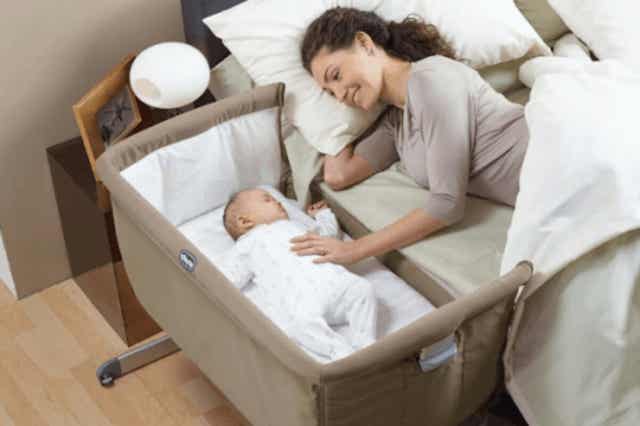How to Transition from Co-Sleeping to a Bed

Currently, there are lots of parents who decide to practice co-sleeping. This is sleeping in the same bed with the baby or with a co-sleeping cot. However, when the time comes, we want our children to start sleeping in their own room. Do you want to transition from co-sleeping to a bed without traumatizing your child? Here are some tips to help you in this important milestone.
This is a big change for the family but you need to do it correctly so it doesn’t cause problems for the child. These tips will help you do it progressively and avoid traumatizing anyone. Do you want to know how to do it? Keep reading and we’ll let you know
How to transition from co-sleeping to a bed without trauma
The American Academy of Pediatrics doesn’t recommend co-sleeping. In addition, it emphasizes that you need to do practice safety measures to reduce the chances of suffocation or choking.

However, on the other hand, there are a large number of specialists who believe that the practice of co-sleeping has enormous benefits, both for the baby and the mother:
- Babies that are with their mother cry less and have less anxiety, as they feel safe and protected.
- Co-sleeping reinforces the emotional bond between the parents and the newborn.
- The baby rests more deeply.
- You wake up fewer times. Also, when you do wake up, it takes less time to fall back asleep.
- The mother also rests better and longer.
- Co-sleeping decreases the risk of Sudden Infant Death Syndrome (SIDS).
When the time comes, the baby grows, and both the parents and baby no longer feel comfortable sharing a bed. Many children begin to need their own space and independence.
When and how to transition from co-sleeping without traumatizing your child
There’s no precise moment to make this chance. The important thing is that it’s the moment that you’ve decided or that you see that your child’s ready. This moment starts when the little one has grown up and needs more space in the bed. So, he kicks around and moves a lot, causing the parents to not sleep well. This is when the parents have to assess whether it’s the right time to make this change or not.
Also, it’s important to make this change progressively. This step involves lots of changes for the child, so we need to be aware of their needs at all times.
Tips for trauma-free co-sleeping transition for kids

Move the crib in the same room as the parents
Move your little one from the parents’ bed to the crib, but in the parents’ room. Once the child sleeps well and has accepted the change, then you can move the crib to their room.
Establish a good sleep routine
It’s very important to have a bedtime ritual that’s predictable and that the child’s used to. For example, you have dinner, then bath time, read a story, then go to sleep.
Make sure it’s a progression
We have to keep in mind that, since they were born, they’ve always been around mom and dad. This means we have to be patient and flexible. The first time you take them to their room, stay with them until they fall asleep.
Never let them cry
Once they’re in their room, when your baby cries, go and see what happens. If you let them cry, you’re allowing them develop high anxiety, and then they won’t get enough rest. You can caress them and talk to them until they fall asleep.
Try not to back down
If you take them out of their bed because they’re having a bad night, it will make the process very difficult.
Don’t scold the child for crying or getting up at night
Each child has their own rhythm and needs that must be respected. The baby needs you to help them adjust with love and affection in this new and unfamiliar situation.
Final thoughts on the transition from co-sleeping to a bed
These are some of the tips that you can use to transition from co-sleeping to a bed without causing trauma to children. Remember that, during this time, rest might not be as good and may be of lower quality. Finally, the most important thing is to be consistent. This way, it will become normal for everyone.
Currently, there are lots of parents who decide to practice co-sleeping. This is sleeping in the same bed with the baby or with a co-sleeping cot. However, when the time comes, we want our children to start sleeping in their own room. Do you want to transition from co-sleeping to a bed without traumatizing your child? Here are some tips to help you in this important milestone.
This is a big change for the family but you need to do it correctly so it doesn’t cause problems for the child. These tips will help you do it progressively and avoid traumatizing anyone. Do you want to know how to do it? Keep reading and we’ll let you know
How to transition from co-sleeping to a bed without trauma
The American Academy of Pediatrics doesn’t recommend co-sleeping. In addition, it emphasizes that you need to do practice safety measures to reduce the chances of suffocation or choking.

However, on the other hand, there are a large number of specialists who believe that the practice of co-sleeping has enormous benefits, both for the baby and the mother:
- Babies that are with their mother cry less and have less anxiety, as they feel safe and protected.
- Co-sleeping reinforces the emotional bond between the parents and the newborn.
- The baby rests more deeply.
- You wake up fewer times. Also, when you do wake up, it takes less time to fall back asleep.
- The mother also rests better and longer.
- Co-sleeping decreases the risk of Sudden Infant Death Syndrome (SIDS).
When the time comes, the baby grows, and both the parents and baby no longer feel comfortable sharing a bed. Many children begin to need their own space and independence.
When and how to transition from co-sleeping without traumatizing your child
There’s no precise moment to make this chance. The important thing is that it’s the moment that you’ve decided or that you see that your child’s ready. This moment starts when the little one has grown up and needs more space in the bed. So, he kicks around and moves a lot, causing the parents to not sleep well. This is when the parents have to assess whether it’s the right time to make this change or not.
Also, it’s important to make this change progressively. This step involves lots of changes for the child, so we need to be aware of their needs at all times.
Tips for trauma-free co-sleeping transition for kids

Move the crib in the same room as the parents
Move your little one from the parents’ bed to the crib, but in the parents’ room. Once the child sleeps well and has accepted the change, then you can move the crib to their room.
Establish a good sleep routine
It’s very important to have a bedtime ritual that’s predictable and that the child’s used to. For example, you have dinner, then bath time, read a story, then go to sleep.
Make sure it’s a progression
We have to keep in mind that, since they were born, they’ve always been around mom and dad. This means we have to be patient and flexible. The first time you take them to their room, stay with them until they fall asleep.
Never let them cry
Once they’re in their room, when your baby cries, go and see what happens. If you let them cry, you’re allowing them develop high anxiety, and then they won’t get enough rest. You can caress them and talk to them until they fall asleep.
Try not to back down
If you take them out of their bed because they’re having a bad night, it will make the process very difficult.
Don’t scold the child for crying or getting up at night
Each child has their own rhythm and needs that must be respected. The baby needs you to help them adjust with love and affection in this new and unfamiliar situation.
Final thoughts on the transition from co-sleeping to a bed
These are some of the tips that you can use to transition from co-sleeping to a bed without causing trauma to children. Remember that, during this time, rest might not be as good and may be of lower quality. Finally, the most important thing is to be consistent. This way, it will become normal for everyone.
This text is provided for informational purposes only and does not replace consultation with a professional. If in doubt, consult your specialist.








